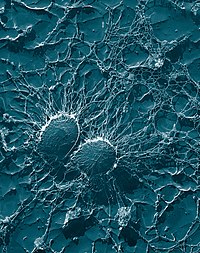
Photo from wikipedia
Panton–Valentine leucocidin (PVL) is a virulence factor produced by certain strains of Staphylococcus aureus (SA). Through its cytolytic action on the cell membranes of human polymorphonuclear neutrophils, PVL causes a… Click to show full abstract
Panton–Valentine leucocidin (PVL) is a virulence factor produced by certain strains of Staphylococcus aureus (SA). Through its cytolytic action on the cell membranes of human polymorphonuclear neutrophils, PVL causes a range of pathologies collectively known as PVL‐SA disease. The hallmark clinical signs of PVL‐SA are recurrent boils and necrotizing skin and soft tissue infections (SSTIs) in otherwise healthy patients; however, it can lead to more severe and invasive presentations, including necrotizing haemorrhagic pneumonia, necrotizing fasciitis and purpura fulminans. Young adults with minimal previous exposure to healthcare settings tend to be at highest risk for acquiring PVL‐SA disease, with close physical contact playing a central role in disease transmission. The prevalence of PVL‐SA varies globally; however, this is often underestimated owing to a lack of routine PVL testing. In the UK, PVL‐positive SA isolates have been rising over the past decade alongside an increasing prevalence of multidrug resistance in larger cities. This review article aims to raise awareness of the PVL toxin, to aid clinicians with diagnostic pointers and to provide guidance with treatment, with an emphasis on the need for further population‐based studies.
Journal Title: Clinical and Experimental Dermatology
Year Published: 2022
Link to full text (if available)
Share on Social Media: Sign Up to like & get
recommendations!